Many people notice their neck skin becoming loose and wrinkled as they age, creating what’s commonly called “turkey neck.” This happens because the skin loses collagen and elastin over time, while gravity pulls the weakened tissue downward.
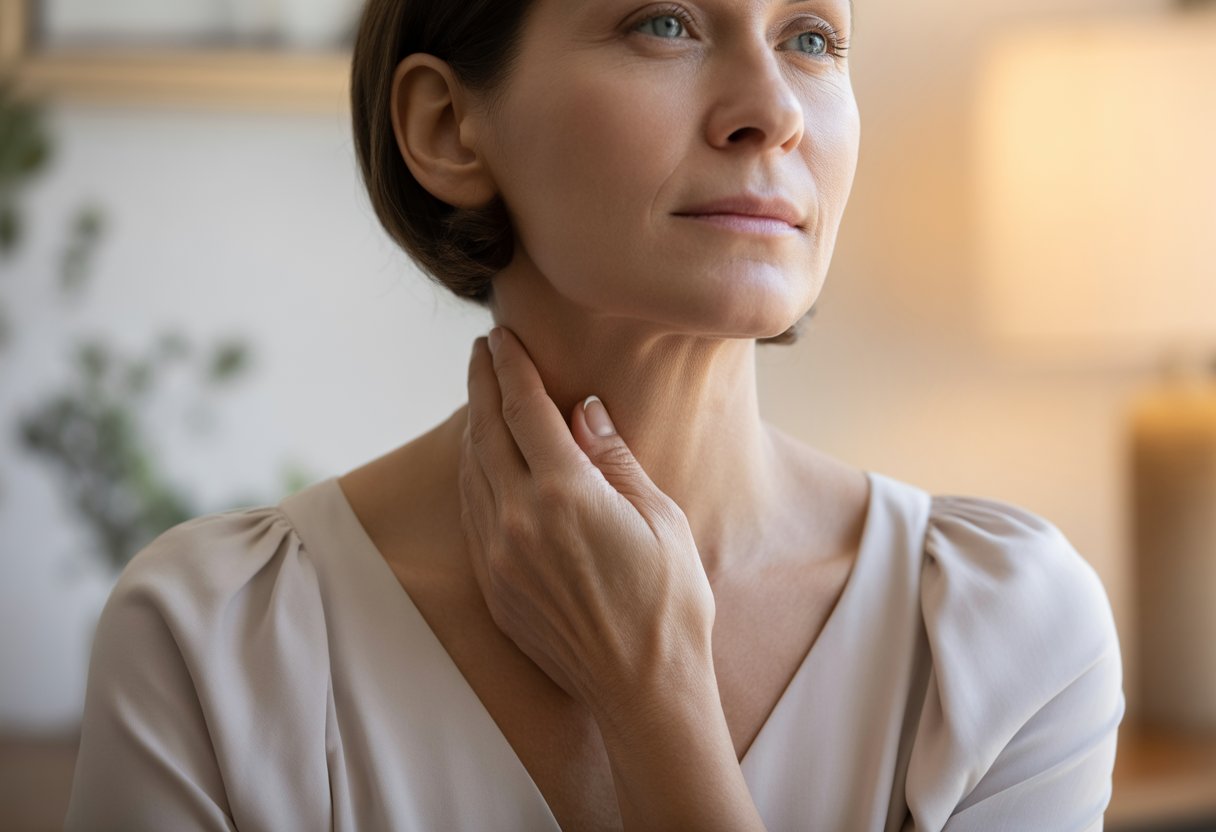
You can fix turkey neck through several methods, including targeted exercises, professional treatments like Botox and radiofrequency procedures, proper skincare, and in severe cases, surgical options like neck lifts. The neck ages faster than other areas because the skin is thinner and gets less attention in daily skincare routines.
The good news is that turkey neck can be treated with both surgical and non-surgical approaches, depending on how severe the sagging appears. From simple at-home exercises to advanced medical procedures, people have many options to improve their neck’s appearance and restore a more youthful look.
Key Takeaways
- Turkey neck develops when neck skin loses elasticity and collagen with age, causing sagging and wrinkles
- Treatment options range from neck exercises and skincare to professional procedures like Botox and surgical neck lifts
- Prevention through proper skincare, sun protection, and neck exercises can help slow down the aging process
Understanding Turtle Neck: Causes and Contributing Factors

Turkey neck develops through a combination of natural aging processes, genetic factors, and environmental damage that break down the skin’s support structure. Collagen and elastin decline over time, while sun exposure and lifestyle choices accelerate the formation of sagging neck skin.
Natural Aging and Skin Changes
The aging process naturally reduces the skin’s ability to maintain firmness and elasticity. As people reach their 40s and 50s, cellular turnover slows significantly.
Key aging changes include:
- Reduced cell regeneration rates
- Decreased natural oil production
- Thinning of the skin layers
- Loss of facial volume
The neck area shows signs of aging earlier than other body parts. This happens because neck skin is thinner and has fewer oil glands than facial skin.
Gravity pulls on loose skin over decades. The constant downward force creates folds and wrinkles that become more pronounced with time.
Muscle tone also decreases with age. The platysma muscles in the neck weaken, providing less support for the overlying skin.
Role of Collagen and Elastin in Skin Structure
Collagen production peaks in a person’s twenties and then declines by about 1% each year. This protein forms the structural foundation that keeps skin tight and smooth.
Elastin works alongside collagen to provide skin flexibility. When elastin fibers break down, the skin loses its ability to bounce back after stretching or movement.
The breakdown process affects:
- Skin thickness and density
- Ability to retain moisture
- Resistance to sagging
- Recovery from daily stress
Environmental factors speed up collagen and elastin loss. Free radicals from pollution and UV rays damage these essential proteins faster than the body can replace them.
The neck area contains less collagen than the face. This makes it more vulnerable to developing turkey neck as support structures weaken.
Impact of Genetics and Lifestyle
Genetics determine baseline collagen quality and skin thickness. Some people inherit stronger skin structure that resists sagging longer than others.
Family history often predicts when and how severely turkey neck will develop. Children of parents with early neck aging may notice changes sooner.
Lifestyle factors that accelerate sagging include:
- Smoking and tobacco use
- Poor nutrition and dehydration
- Lack of exercise
- Excessive weight fluctuations
Sleep position affects neck skin over time. Sleeping on one’s stomach or side with the neck twisted can create permanent creases.
Repetitive movements like looking down at phones create “tech neck.” This modern habit accelerates the formation of horizontal lines and sagging.
Weight gain stretches neck skin beyond its elastic limit. Rapid weight loss then leaves excess skin that cannot shrink back to its original size.
Effects of Sun Exposure and Other Environmental Factors
UV radiation breaks down collagen and elastin fibers through a process called photoaging. The neck receives significant sun exposure but often lacks proper protection.
UVA rays penetrate deep into the skin and cause long-term structural damage. UVB rays affect surface layers and create immediate visible changes like wrinkles.
Environmental damage sources:
- Direct sunlight exposure
- Reflected UV from water or snow
- Indoor UV from windows
- Air pollution and toxins
The chest and neck area often get forgotten during sunscreen application. This leads to accelerated aging compared to the protected face.
Pollution creates free radicals that attack skin proteins. Urban environments with high pollution levels show increased rates of premature neck aging.
Heat and wind also dry out neck skin. These conditions reduce the skin’s natural moisture barrier and flexibility over time.
Recognizing Symptoms: Identifying Saggy and Wrinkled Neck Skin
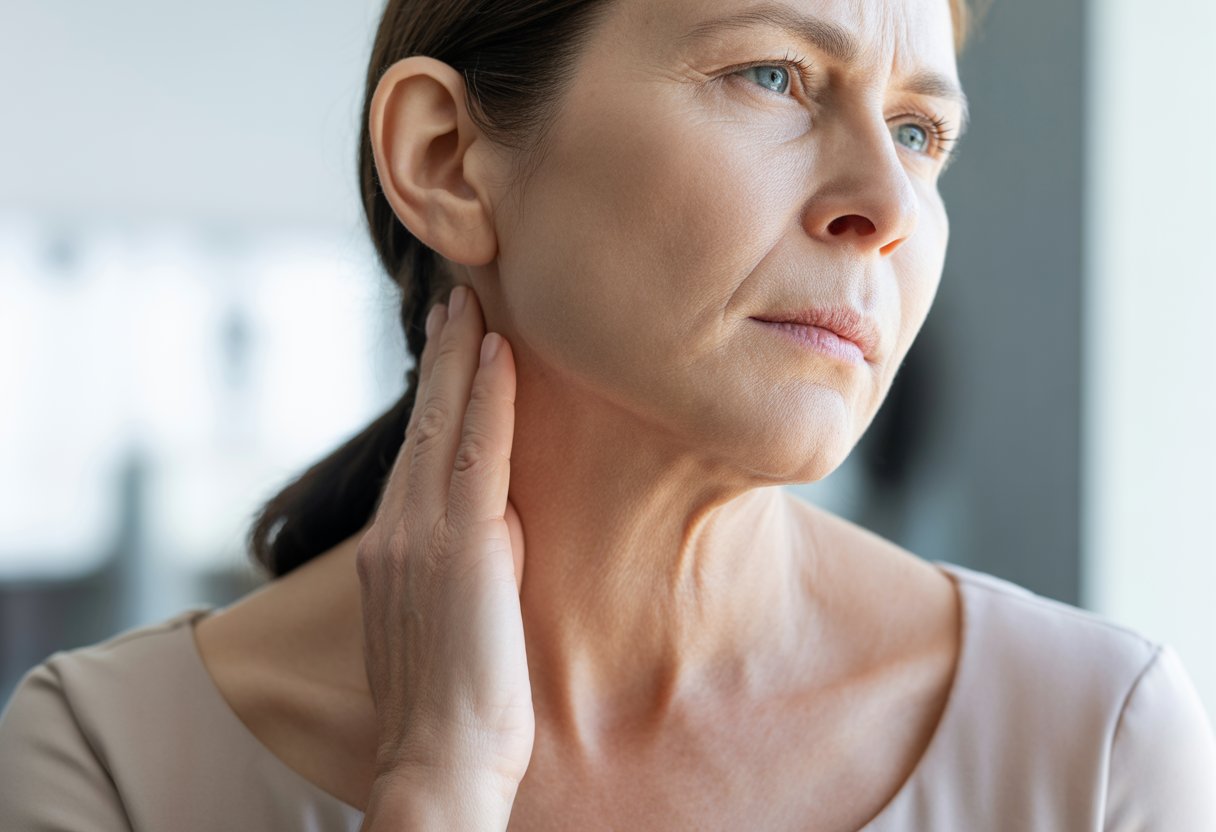
The neck shows specific signs of aging that differ from facial changes, with distinct visual markers and texture changes. Understanding these symptoms helps people identify when their neck skin needs attention.
Visible Signs of Aging on the Neck
The neck develops loose, hanging skin that creates a droopy appearance below the chin. This sagging typically starts as mild looseness and progresses to more noticeable folds over time.
Horizontal lines form across the neck from repeated movements and sleeping positions. These lines become deeper and more permanent as skin loses its ability to bounce back.
Vertical bands appear on either side of the neck as muscles weaken and become more visible. The skin between these bands often looks loose and wrinkled.
Turkey neck symptoms include both the saggy skin under the chin and the vertical creases that develop over long periods. The skin may also develop a crepey texture that feels thin and fragile to touch.
Dark spots and uneven skin tone often accompany these changes. The neck area may look older than the face because it receives less daily skincare attention.
Differences Between Sagging, Wrinkling, and Excess Skin
Sagging occurs when weakened neck muscles cause skin to lose its support structure. The skin hangs down instead of staying tight against the neck.
Wrinkling creates lines and creases in the skin surface. These can be fine lines from sun damage or deeper grooves from muscle movement and gravity.
Excess skin means there is simply too much skin for the underlying structure. This happens when skin stretches over time and cannot shrink back to its original size.
Key differences include:
- Sagging: Skin hangs loose but may still feel thick
- Wrinkling: Lines form but skin stays in place
- Excess skin: Too much skin creates folds and bunching
Neck wrinkle types fall into horizontal versus vertical categories, with each having different underlying causes and treatment needs.
Impact on Skin Texture and Appearance
The neck’s skin texture becomes rougher and less smooth as aging progresses. What once felt firm and elastic now feels soft and loose when touched.
Skin elasticity decreases significantly in the neck area. When pinched, the skin takes longer to return to its normal position or may not fully bounce back.
Thinner neck skin shows aging effects faster than facial skin because it has less natural support. This makes wrinkles and sagging more noticeable earlier in the aging process.
The surface may develop a crepey appearance similar to tissue paper. Fine lines multiply and connect to create larger areas of textured, uneven skin.
Color changes often occur alongside texture problems. The skin may look duller, develop age spots, or show redness from irritation caused by loose skin rubbing together.
Prevention Strategies for Turtle Neck

Protecting the neck from sun damage, maintaining healthy lifestyle habits, and supporting collagen production through proper nutrition can significantly reduce the risk of developing saggy, wrinkled neck skin. These preventive measures work together to keep neck skin firm and elastic over time.
Importance of Sun Protection and Sunscreen
The neck receives constant sun exposure but often gets overlooked during daily skincare routines. UV rays break down collagen and elastin fibers in the skin, leading to premature aging and sagging.
People should apply broad-spectrum SPF 30 or higher sunscreen to their neck every morning. The neck area needs the same protection as the face since it has thin, delicate skin.
Reapplying sunscreen every two hours becomes essential during outdoor activities. Many people forget to include their neck when reapplying, which creates uneven protection.
Additional sun protection strategies include:
- Wearing high-collared shirts or scarves
- Seeking shade during peak UV hours (10 AM to 4 PM)
- Using UV-protective clothing with UPF ratings
Physical barriers work alongside sunscreen for maximum protection. Wide-brimmed hats can shield the neck from overhead sun exposure.
Lifestyle Changes for Long-Term Skin Health
A healthy lifestyle directly impacts skin quality and can prevent premature neck aging. Poor posture from prolonged screen use contributes to turtle neck syndrome and accelerates skin sagging.
Sleep position affects neck skin over time. Sleeping on one’s back prevents pillow creases and reduces pressure on neck skin. Side sleepers should use silk or satin pillowcases to minimize friction.
Regular exercise improves blood circulation to the skin. Better circulation delivers nutrients and oxygen to skin cells, supporting natural repair processes.
Key lifestyle factors include:
- Maintaining proper posture during computer work
- Taking breaks from screens every 30 minutes
- Avoiding smoking, which damages collagen
- Limiting alcohol consumption
- Getting 7-9 hours of quality sleep
Stress management also plays a role in skin health. Chronic stress increases cortisol levels, which can break down collagen and accelerate aging.
Diet and Hydration for Collagen Maintenance
Proper nutrition provides the building blocks for collagen production and skin repair. The body needs specific nutrients to maintain skin elasticity and prevent sagging.
Collagen-supporting nutrients include:
- Vitamin C (citrus fruits, berries, leafy greens)
- Protein (fish, lean meats, legumes, eggs)
- Omega-3 fatty acids (salmon, walnuts, flaxseeds)
- Antioxidants (colorful vegetables and fruits)
Adequate water intake keeps skin cells hydrated and plump. Dehydrated skin appears more wrinkled and loses elasticity faster.
People should aim for 8-10 glasses of water daily and increase intake during hot weather or exercise. Herbal teas and water-rich foods like cucumbers also contribute to hydration.
Foods that support skin health:
| Nutrient | Food Sources | Benefits |
|---|---|---|
| Vitamin C | Oranges, strawberries, bell peppers | Collagen synthesis |
| Zinc | Pumpkin seeds, chickpeas | Skin repair |
| Selenium | Brazil nuts, tuna | Protects against UV damage |
Limiting sugar intake prevents glycation, a process that damages collagen fibers and leads to skin aging.
Non-Surgical Treatments and Skin Care Solutions
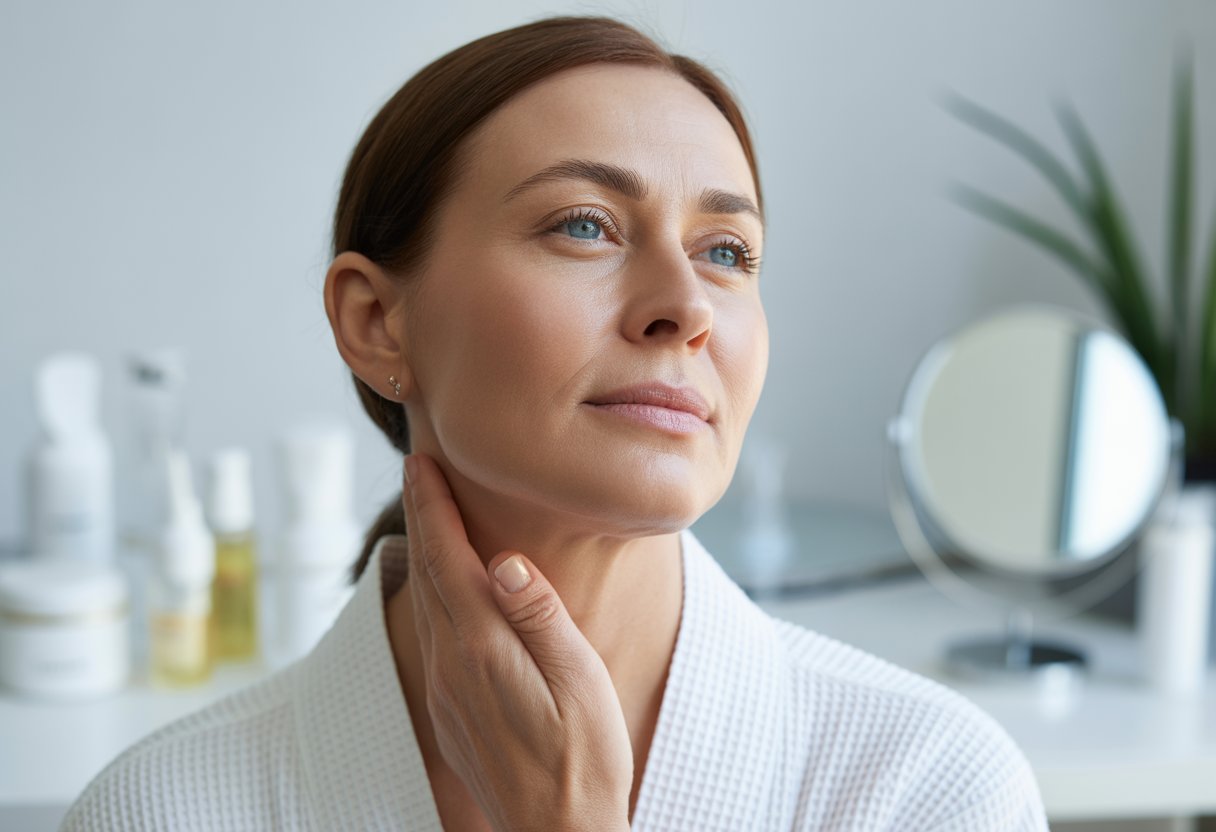
Targeted skincare ingredients like retinol and n-acetyl glucosamine can help improve neck skin texture and reduce visible signs of aging. Anti-aging skin care routines including neck creams and lotions can help minimize collagen loss and tighten skin.
Topical Anti-Aging Creams and Ingredients
Anti-aging creams specifically formulated for the neck contain active ingredients that target loose skin and wrinkles. These products work by stimulating collagen production and improving skin elasticity over time.
Key ingredients to look for include:
- Peptides that signal skin cells to produce more collagen
- Hyaluronic acid for deep hydration and plumping effects
- Vitamin C to protect against environmental damage
- Alpha hydroxy acids to promote cell turnover
The neck area has thinner skin than the face. This means it absorbs products differently and may be more sensitive to certain ingredients.
People should apply neck creams twice daily using upward motions from the collarbone to the jawline. Consistency is essential for seeing results, which typically appear after 8-12 weeks of regular use.
Cosmetic Creams with Proven Efficacy
Several cosmetic creams have clinical research supporting their effectiveness for neck skin improvement. These products contain higher concentrations of active ingredients compared to basic moisturizers.
Proven cream types include:
- Firming creams with DMAE that may tighten skin appearance
- Lifting creams containing caffeine to temporarily reduce puffiness
- Repair creams with growth factors to support skin regeneration
Prescription-strength creams from dermatologists often show faster results than over-the-counter options. These medical-grade formulations contain ingredients at therapeutic levels.
Users should patch test new creams on a small neck area first. Some people experience irritation or redness when starting stronger formulations.
Retinol and N-Acetyl Glucosamine Benefits
Retinol stands as one of the most researched anti-aging ingredients for neck skin improvement. This vitamin A derivative increases cell turnover and stimulates collagen production in the deeper skin layers.
Retinol benefits for neck skin:
- Reduces fine lines and wrinkles
- Improves skin texture and smoothness
- Increases firmness over time
- Fades age spots and discoloration
N-acetyl glucosamine works alongside retinol to enhance skin renewal. This amino sugar derivative helps break down pigmentation and supports the skin barrier function.
People should start with low-concentration retinol products (0.25-0.5%) to build tolerance. The neck area can be more sensitive than facial skin to retinol irritation.
Application tips:
- Use retinol products only at night
- Apply sunscreen daily when using retinol
- Start with 2-3 times per week, gradually increasing frequency
Non-Invasive Procedures for Neck Tightening
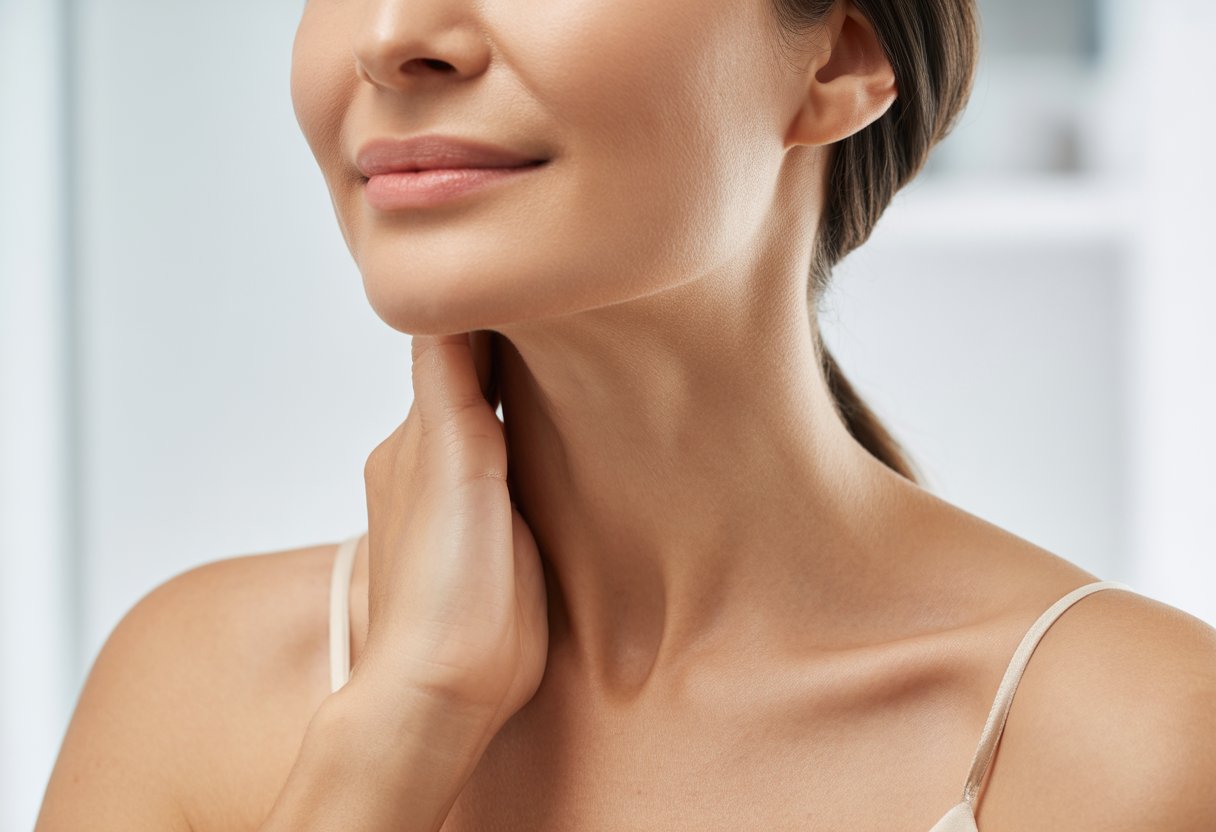
Several non-surgical treatments can effectively address sagging neck skin without the risks of surgery. These procedures use advanced technology to stimulate collagen production and tighten loose skin through controlled energy delivery.
Radiofrequency and Ultrasound Therapy
Radiofrequency treatments heat the deeper layers of skin to stimulate collagen production. The controlled heat causes existing collagen fibers to contract while encouraging new collagen growth over several months.
Popular RF devices include:
- Thermage
- Exilis Ultra
- Venus Freeze
Ultrasound therapy works similarly by delivering focused energy to specific skin depths. Ultherapy is the most common ultrasound treatment for neck tightening.
These skin tightening treatments typically require 1-3 sessions. Patients see gradual improvements over 3-6 months as new collagen develops.
Most people experience mild discomfort during treatment. The skin may appear red for a few hours afterward.
Results last 12-18 months on average. Some patients need maintenance treatments to sustain the tightening effects.
Microneedling Techniques for Skin Firmness
Microneedling creates tiny punctures in the skin using fine needles. This controlled injury triggers the body’s natural healing response and collagen production.
Two main types exist:
- Traditional microneedling with topical serums
- Radiofrequency microneedling (Morpheus8, Profound RF)
The RF version combines microneedling with radiofrequency energy. This delivers heat directly into the deeper skin layers for enhanced results.
Treatment sessions typically last 30-60 minutes. Patients need 3-6 sessions spaced 4-6 weeks apart for optimal results.
The skin appears red and feels tender for 1-3 days post-treatment. Peeling may occur as the skin heals and regenerates.
Results become visible after 4-6 weeks. The skin continues improving for several months as new collagen forms.
Laser Skin Resurfacing Options
Laser treatments remove damaged skin layers and stimulate collagen production. Two main categories address different concerns and recovery preferences.
Ablative lasers remove the top skin layer completely:
- CO2 lasers
- Erbium lasers
- Require 1-2 weeks downtime
Non-ablative lasers heat deeper layers without removing surface skin:
- Fraxel
- Clear + Brilliant
- Minimal downtime required
Skin resurfacing treatments typically require 1-3 sessions depending on the laser type and skin condition.
Fractional lasers treat only portions of the skin surface. This approach reduces recovery time while still providing effective results.
Patients see improvements in skin texture and firmness within 2-4 weeks. Results continue developing for 3-6 months as collagen remodeling occurs.
Surgical and Minimally Invasive Solutions
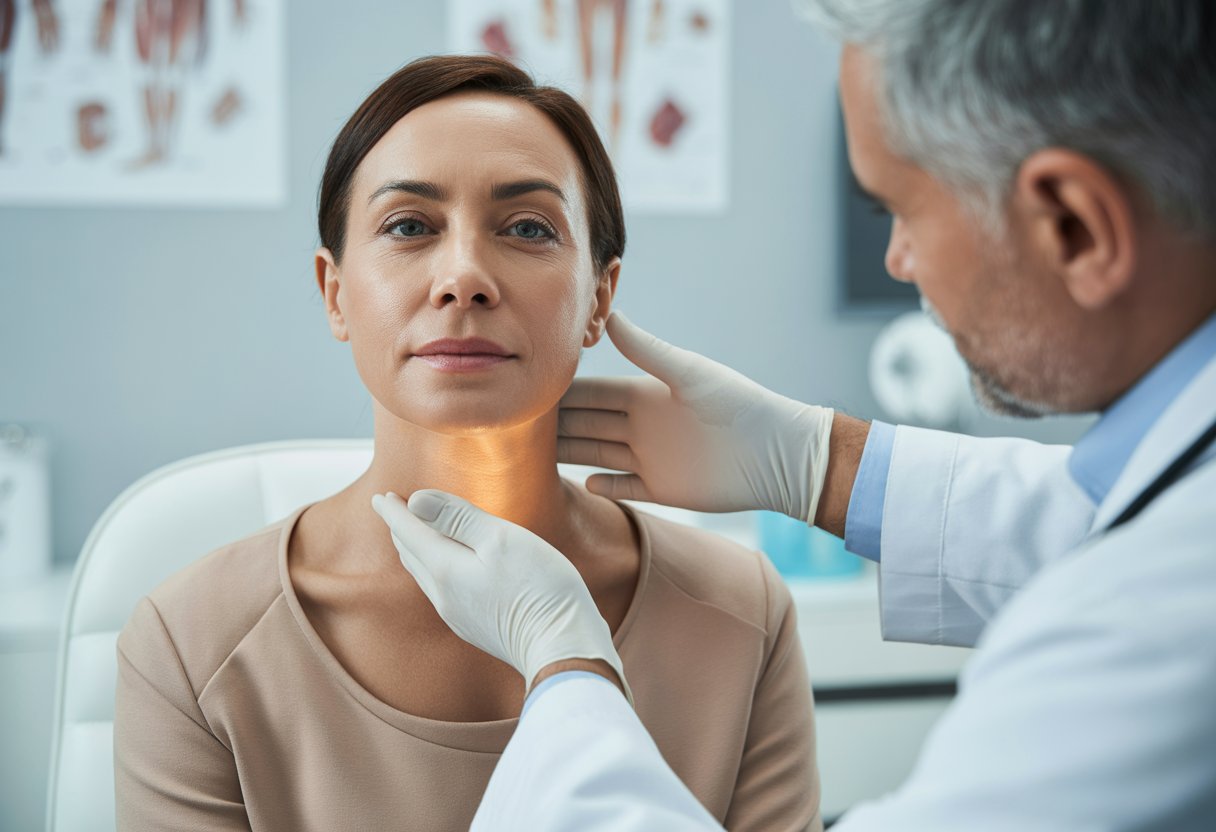
Advanced medical treatments offer effective ways to address sagging neck skin through surgical procedures and less invasive options. These methods range from comprehensive neck lift surgery to targeted treatments like Botox injections and thread lifts.
Neck Lift Surgery Explained
A neck lift surgery removes excess skin and tightens underlying muscles in the neck area. Doctors make small cuts behind the ears and under the chin to access the neck tissues.
The surgeon removes loose skin and repositions the neck muscles. This creates a smoother, more youthful neck appearance.
Types of neck lift procedures include:
- Full neck lift with face lift
- Mini neck lift focusing only on the neck area
- Limited incision neck lift
Recovery takes about 2-3 weeks for most patients. Swelling and bruising are normal during the first week after surgery.
A mini-neck lift procedure uses smaller cuts and focuses on the area under the chin. This option works well for people with mild to moderate neck sagging.
The results from neck lift surgery can last 10-15 years. Most patients see significant improvement in their neck appearance.
Botox and Thread Lift Procedures
Botox injections relax neck muscles that create vertical bands or lines. The treatment takes about 15-20 minutes and requires no downtime.
Results from neck botox appear within 3-7 days after treatment. The effects typically last 3-4 months before another treatment is needed.
A neck thread lift uses special threads to lift sagging skin without surgery. Doctors insert thin threads under the skin to create support and lift the neck area.
Thread lift benefits:
- Minimal downtime
- Local anesthesia only
- Results visible immediately
- Treatment takes 30-60 minutes
FaceTite treatment uses heat energy to tighten neck skin from inside. This procedure combines skin tightening with fat removal through small incisions.
Thread lift results last 1-2 years on average. Some patients may experience mild swelling for a few days after treatment.
Comparing Results and Risks
Surgery vs. Non-Surgical Results:
| Treatment Type | Results Duration | Downtime | Risk Level |
|---|---|---|---|
| Neck Lift Surgery | 10-15 years | 2-3 weeks | Higher |
| Thread Lift | 1-2 years | 2-3 days | Lower |
| Botox | 3-4 months | None | Minimal |
Surgical neck lifts provide the most dramatic and long-lasting results. However, they carry higher risks including infection, scarring, and nerve damage.
Thread lifts offer moderate improvement with less risk. The main side effects include temporary swelling and minor bruising.
Botox treatments have minimal risks but provide subtle results. Side effects are rare and usually include temporary muscle weakness.
Multiple treatment options allow patients to choose based on their specific needs and comfort level. Severe neck sagging typically requires surgical intervention for best results.
Cost varies significantly between treatments. Non-surgical options cost less initially but require repeat treatments over time.
Exercise and At-Home Practices

Simple exercises and daily habits can strengthen neck muscles and improve skin appearance over time. Regular massage techniques and proper posture work together with targeted movements to support healthier neck skin.
Effective Neck Exercises for Muscle Tone
Neck lifts target the muscles under the chin and along the throat. A person lies flat on their back and slowly lifts their head off the ground while keeping shoulders down. Hold for 5 seconds and repeat 10 times.
Chin tucks help strengthen deep neck muscles. Pull the chin straight back toward the neck while sitting or standing tall. This creates a double chin effect. Hold for 3 seconds and repeat 15 times throughout the day.
The neck stretch involves tilting the head to one side and gently pulling with the same-side hand. Hold for 15 seconds on each side. This exercise helps tighten neck skin while improving flexibility.
Jaw releases work the muscles around the jawline and upper neck. Open the mouth wide and move the jaw in circular motions. Do 10 circles in each direction twice daily.
These neck tightening exercises should be done 3-5 times per week for best results.
Incorporating Neck Massage and Good Posture
Daily neck massage improves blood flow to the skin. Use upward strokes from the collarbone to the jawline with gentle pressure. Apply a moisturizer during massage to reduce friction.
Proper posture prevents additional sagging. Keep the head aligned over the shoulders instead of jutting forward. This reduces strain on neck muscles and skin.
When using phones or computers, raise screens to eye level. Looking down constantly stretches the neck skin and weakens supporting muscles.
Sleep with proper neck support using a pillow that keeps the spine straight. Side sleepers need a thicker pillow than back sleepers.
Take breaks every 30 minutes to roll shoulders back and stretch the neck gently.
Daily Routines for Ongoing Skin Support
Morning routines should include gentle neck exercises and moisturizer application. Apply sunscreen to the neck area to prevent further skin damage from UV rays.
Evening care involves removing makeup and applying anti-aging creams with upward motions. Use products with ingredients that support skin firmness.
Stay hydrated by drinking 8 glasses of water daily. Proper hydration keeps skin plump and reduces the appearance of wrinkles.
Consistent sleep schedules help the body repair skin overnight. Aim for 7-8 hours of quality sleep each night.
These natural methods to get rid of turkey neck work best when combined into a daily routine. Results typically become visible after 6-8 weeks of regular practice.
Frequently Asked Questions

People often wonder about exercise routines for turkey neck and whether diet changes can help tighten loose skin. Many also ask about natural remedies, quick fixes, and what causes sudden sagging around the neck area.
What are the most effective exercises for reducing the appearance of turkey neck?
Neck tightening exercises can help strengthen the muscles under the chin and along the neck. The most effective moves include neck stretches, resistance exercises, and targeted muscle contractions.
One simple exercise involves tilting the head back and pushing the lower jaw forward to stretch the neck muscles. Another effective move is placing the tongue on the roof of the mouth while tilting the head back.
Chin tucks work well for strengthening neck muscles. A person sits up straight and pulls their chin toward their chest while keeping their head level.
These exercises should be done daily for several weeks to see results. Turkey neck exercises may help tighten muscles but cannot remove excess skin completely.
Can diet and weight loss contribute to improving the condition of saggy neck skin?
Weight changes can affect neck skin appearance. Weight gain can permanently stretch the skin around the neck area, making it sag more when weight is lost later.
Maintaining a stable weight helps prevent further stretching of neck skin. Eating foods rich in collagen-building nutrients like vitamin C and protein may support skin health.
Staying hydrated keeps skin more plump and elastic. However, diet alone cannot reverse significant sagging that has already developed.
Weight loss can sometimes make turkey neck more noticeable by reducing fat that was filling out the skin. The loose skin becomes more visible once the underlying fat is gone.
What natural methods are available for tightening loose neck skin as one ages?
Natural methods focus on supporting skin health from the inside and outside. Applying moisturizers with ingredients like retinol or peptides can help improve skin texture over time.
Facial massage may boost blood flow to the neck area. Some people use jade rollers or gua sha tools to massage the neck and jawline.
Sun protection prevents further damage to neck skin. Wearing sunscreen daily helps slow the breakdown of collagen and elastin.
Cold treatments like ice packs may temporarily tighten skin by causing blood vessels to contract. However, these effects are short-lived and do not create lasting changes.
Is it possible to achieve instant results in treating turkey neck without surgery?
True instant results for turkey neck are not possible without medical procedures. Turkey neck develops due to loss of collagen and elastin, which cannot be reversed immediately.
Some makeup techniques can create the appearance of a more defined jawline. Contouring with darker shades under the chin can make sagging less noticeable.
Certain clothing styles like turtlenecks or scarves can hide turkey neck. High necklines draw attention away from loose skin in the neck area.
Temporary skin-tightening products may provide slight firming effects for a few hours. These products work by causing mild skin contraction but do not address underlying structural changes.
How does the act of chewing gum relate to the firmness of neck skin?
Chewing gum exercises the jaw muscles but has limited effects on neck skin firmness. The repetitive chewing motion may strengthen muscles around the jawline slightly.
Some people believe that chewing gum can help define the jaw and reduce double chin appearance. However, there is little scientific evidence to support significant skin tightening from gum chewing alone.
Excessive gum chewing might actually cause jaw tension or TMJ problems. It can also lead to overdeveloped jaw muscles that change facial proportions.
The muscles used for chewing are different from those that support neck skin. Chewing gum does not directly target the platysma muscle responsible for neck sagging.
What causes the sudden development of turkey neck, and how can it be addressed?
Turkey neck typically develops gradually with aging rather than appearing suddenly. The skin loses elasticity over time as collagen production decreases.
Sudden weight loss can make existing turkey neck more noticeable. When fat under the chin disappears quickly, loose skin becomes more apparent.
Genetics play a major role in how fast neck skin ages. Some people develop sagging earlier due to their family history and skin type.
Sun damage accelerates the breakdown of skin proteins in the neck area. Years of UV exposure can cause premature aging that seems to appear suddenly.
Addressing turkey neck requires consistent effort through exercises, skincare, or professional treatments. Medical procedures like Botox, Kybella, or surgery provide more dramatic results than at-home methods.